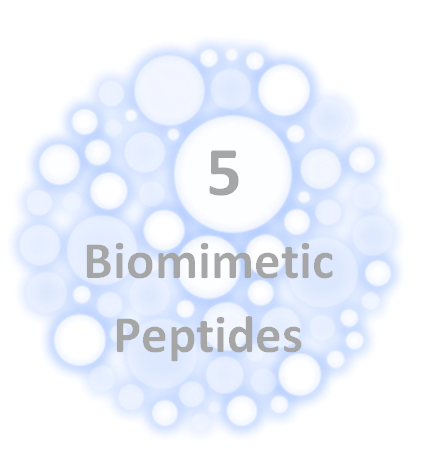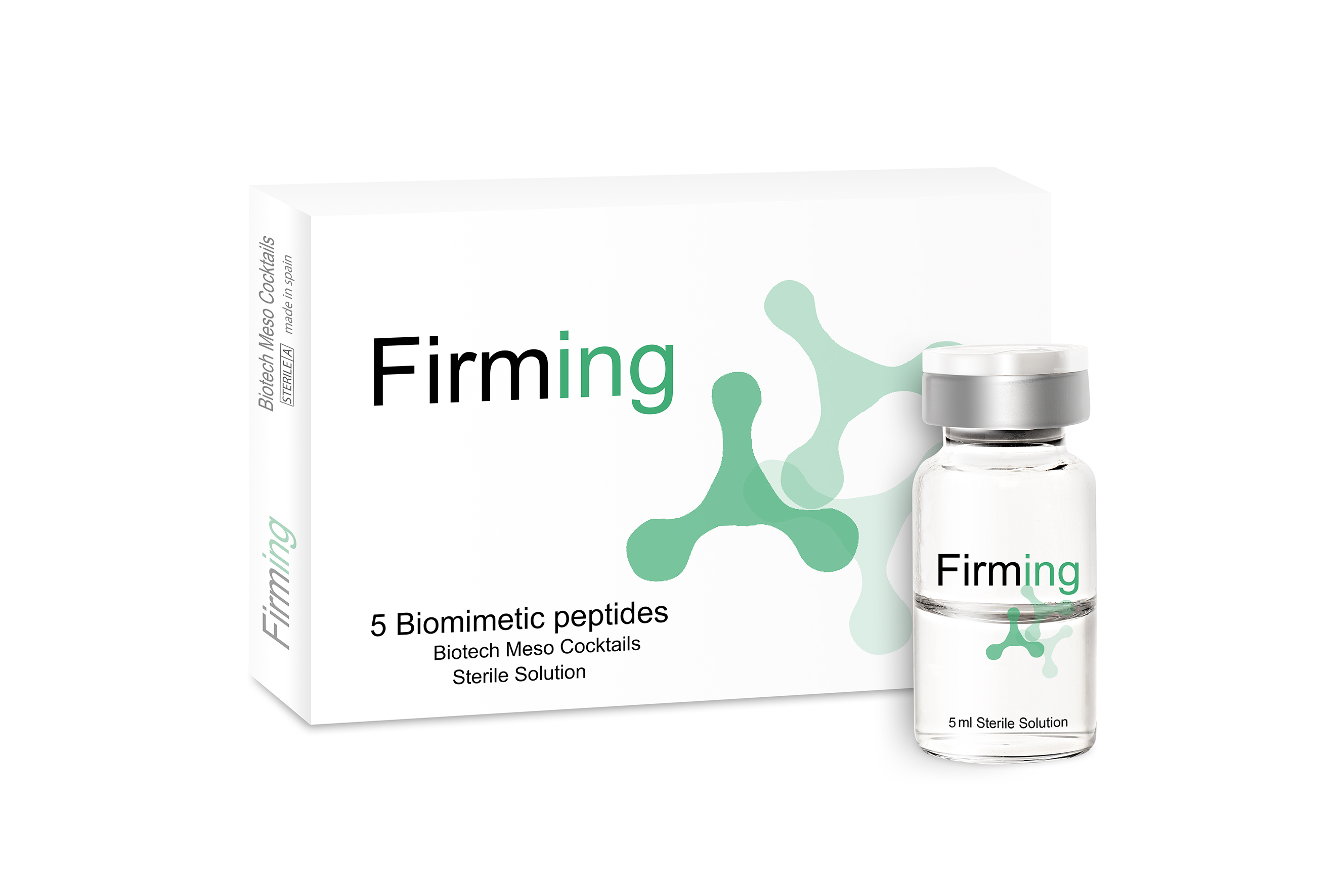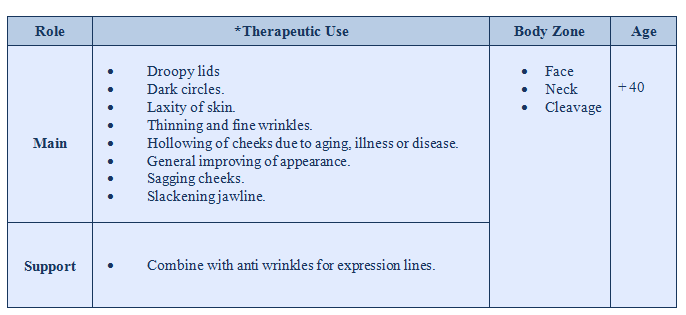INGREDIENTS
Hyaluronic acid , multivitamins (14) , oligoelements (10), multiaminoacids (24), coenzyme A, nicotinamide adenine dinucleotide NAD, thiamine diphosphate (cocarboxhylase), disodium flavine adenine dinucleotide, nucleic acids (6), ALA (sodium R alpha Lipoate), glutathione, hydrosoluble collagen, Dimethyl MEA, methylsilanol mannuronate, 2 more key ingredients and 5 biomimetic peptides:
ascorbic acid (3-O-ethyl- ascorbic acid) and Milk Peptide complex. Peptides: Tripeptide-5, Tripeptide-10, Tripeptide-28, Tripeptide -38, Oligopeptide-24.
Fill in the form below to access all information about this product.Already a member? Login to access hidden info

COSMECEUTIC AND THERAPEUTIC DIRECTIONS
This product is able to create several mechanisms to mainly increase collagen skin levels. Among them, we stress the ability to mimic proteins like Decorin witch play a main role in collagen fibers organization by controlling its dimension and uniformity. On the other hand acts as a turn on gene responsible of collagen production. Another mechanism is by acting as a grow factor TGF-beta.
The results are impressive, create fresh youthful and glowing complexion. It slows down aging process and gets an overall firming effect in the skin.
*These are advisable therapeutic uses, but the ingredients of products may allow a physician to apply them under professional criteria, may find the product optimal to treat other aesthetic issues.CLINICAL DATA
Pharmacology
Pharmacology of the actives compounds in the formula which promotes firming effect:
DMAE:
- The acute skin-firming effects of DMAE have been confirmed by quantitative measures of cutaneous tensile strength. Although its mechanisms of action in the skin remain to be elucidated, evidence suggests that the skin is an active site of acetylcholine synthesis, storage, secretion, metabolism, and receptivity. Muscarinic acetylcholine receptors have been localized to keratinocytes, melanocytes and dermal fibroblasts, whereas nicotinic acetylcholine receptors have been found in keratinocytes.
- DMAE is an analog of the B vitamin choline and is a precursor of acetylcholine, the firming action of DMAE is explained by the fact that its molecule, considered to be a precursor of acetylcholine, alters muscle contraction.
- The benefits of DMAE in dermatology include a potential anti-inflammatory effect and a documented increase in skin firmness with possible improvement in underlying facial muscle tone.
- It is demonstrated the activity over muscle fibers improving their firmness and thus gives tone to the skin.

- The activity is based on activated Cytokines as a key regulators of cell functions in our body. Cytokines transfer stimulatory or inhibitory signals to the cells in order to render cell responds resulting in restoration of a physiological balanced skin.
- This peptide is shown to be a strong activator of regenerative cell functions.
- It is acting as a booster of collagen synthesis and that of other Extra Cellular Matrix (ECM) compounds leading to a reorganization of the ECM.
- This peptide helps the skin to restore its functions and appearance in relation to its respective age.
Methylsilanol Manuronate:
- Silicon is a constitutive element of the cutaneus connective tissue which takes part in the formation and organization of extracellular matrix (ECM). The natural concentration of Si decreases with aging and leads to tissue destructuration, skin aging and wrinkles.
- Silanols are capable to substitute that loss of silicon an thus help in restructuring connective tissue by slowing down the effects of aging.
- The activity of silicon has been proven through the restructuration of connective tissue and the multiple effects: antiwrinkles, firming, stimulation, moisturization, …)
- Silanol activities on collagen production, promoting a firm and young skin aspect, is a direct consequence of their cytostimulating effects demonstrates on fibroblasts cultures.

- It is able to activate tissue growth factor (TGF-beta) that stimulates collagen synthesis in the skin.
- Potent stimulation of collagen synthesis in the skin, actively effaces any type of wrinkle, good skin firming & moisturizing properties, able to repair stretch marks.
- It overrides the effects of Matrix Metalloproteinase (MMP) enzymes that contribute to skin aging.

- Decorin interacts with collagen via its protein core and influences collagen fibrillogenesis, thus regulating excessive bundle-like aggregation of collagen. As skin ages, there is lack of functional decorin, which results in disrupted collagen fibres and in a reduction in the tensile strength of the skin. Therefore, a substitute for decorin would make up for the non-functional decorin that is present as we age. This peptide sequence has been identified as the specific binding sites of decorin to collagen fibrils. This sequence was engineered to generate new peptide with improved affinity that would present a decorin-like activity.
- This peptide acts as a Decorin like to regulate collagen fibrillogenesis and to influence the diameter of collagen fibres, making them thinner and more uniform. It is a new cosmetic active to target specifically collagen fiber organization. Skin collagen quality is addressed rather than skin collagen quantity. This peptide ensures uniformity in fibril diameter and increases skin suppleness because of a better cohesion of collagen fibres.
- In short, this peptide presents the best Decorin biomimetic activity results interacting with collagen fibrils, regulating the fibrillogenesis process, controlling fibril dimensions and diameter uniformity, thus helping to establish and maintain skin mechanical properties and morphology.

- A stabilized peptide engineered for cutaneous delivery that is resistant to enzyme degradation. It mimics TGF-β β by activation of the transforming growth factor-ββ receptor Type II (TβRII) to activate collagen synthesis. In consequence, it reduces wrinkles by increasing collagen in the skin.
- It works by turning on the gene responsible for the production of collagen.
- Reduction in wrinkles in 28 days (In-vivo).
- Increase in Collagen I Synthesis (in-vitro).
- Increase in Collagen III Synthesis (In-vitro).

- This peptide will affect the six major structural components of the skin to stimulate collagen and diminish or even prevent fine lines, increase hydration levels, and protect and repair damaged skin.
The dermal-epidermal junction (DEJ) is where the epidermis, the top layer of the skin, meets the dermis, the lower layers of the skin. There is no blood flow in the dermis, so it relies on the epidermis for nourishment and protection. The epidermis sends efficacious ingredients from skin care products to the dermis through collagen channels.This peptide strengthens collagen; thereby, enhancing the communication between the epidermis and dermis. This helps create a fresh, youthful and glowing complexion.

- Enhances skin tone that brimming with vitality and energy.
- Minimize scars on skin by forming new skin cell.
- Up-regulation of cell growth and migration, cell survival and extracellular matrix expression.
- Cell Proliferation with Keratinocyte and Fibroblast Cells
- Increased fibroblasts and keratinocytes proliferation in dose-dependent manner.
- It has showed positive regulation of Hyaluronic acid and Fibronectin expression. Increased expression of hyaluronic acid (3 folds) and Elastin (1.3 fold) was observed in dose-dependent manner in fibroblast cell.
- This molecule increases cell survival of keratinocytes cell line by its anti apoptosis attribute, also enhances the attachment of cell by means of EGF growing epidermic factor regulation.
Posology and way of administration
They should be done by the supervision of a doctor or a registered nurse and they will apply the best technique available in each case.
The product is developed sterile, preservative free and pyrogen free to be used on several aesthetic techniques, IPL, roller and other invasive or non invasive procedures.



 English
English